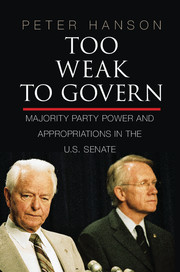4 - Back to the Regular Order
Published online by Cambridge University Press: 05 November 2014
Summary
In the early 1980s, the struggles of a weak Senate majority party helped to establish the new practice of packaging regular appropriations bills together as omnibus bills. This contentious practice gained momentum as President Ronald Reagan entered his second term. Congress packaged all thirteen bills together for passage in 1986 and 1987, leading to complaints from members and from the president himself. Then, in an abrupt shift, Congress abandoned omnibus legislating. Each appropriations bill was passed in the regular order from 1988 to 1994. Omnibus bills did not return until April of 1996 when the passage of a five-bill package signaled the end of a budget crisis that tarnished Newt Gingrich’s “Republican Revolution” and breathed political life back into Bill Clinton’s presidency.
Chapter 4 explores the abandonment and resumption of omnibus legislating and the seven-year period of regular order between them. I test whether the patterns of this time fit the expectations of the limited influence theory. The first section of the chapter reviews changes in the political landscape and Senate majority power that commenced with the Democratic takeover of the Senate in 1986. The second section presents the results of brief case studies of the Senate’s consideration of spending bills, including the resumption of the regular order at the end of President Reagan’s administration and the return of omnibus bills in the Clinton era. The chapter concludes with an investigation of the relationship between executive–legislative conflict and the creation of omnibus spending bills.
- Type
- Chapter
- Information
- Too Weak to GovernMajority Party Power and Appropriations in the U.S. Senate, pp. 99 - 130Publisher: Cambridge University PressPrint publication year: 2014



